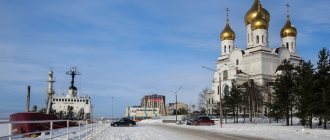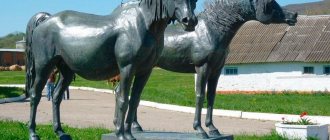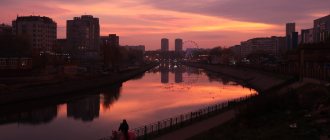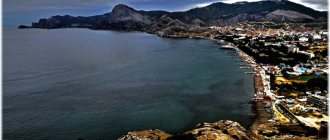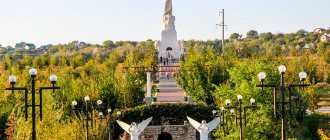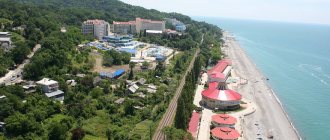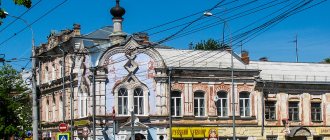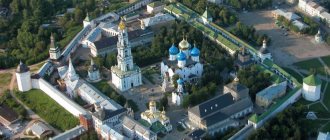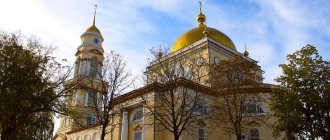To visit Europe, admire stone medieval houses and walk along cobblestone streets, it is not at all necessary to obtain a Schengen visa and save for an expensive trip; it is enough to buy a ticket to the city of Vyborg, which is located 140 km from St. Petersburg.
Vyborg is truly a unique city for Russia! Despite the depressing state of many buildings, it is here that you can see a whole layer of preserved Western European medieval settlements, which absorbed the culture of four peoples at once: Swedish, Prussian, Finnish and German.
We will tell you the history of this small, but undoubtedly interesting city, and also introduce you to the most iconic and valuable historical sights that can easily be seen in one day.
Vyborg Castle
Undoubtedly, the main attraction of Vyborg is the Vyborg Castle . It was built in 1293 on a small rocky island during the Third Swedish Crusade to the Karelian lands. From its founding until 1710, Vyborg Castle remained an impregnable outpost, and its dominant watchtower and battle tower of St. Olav was long considered the tallest tower in Scandinavia.
Vyborg Castle
Vyborg Castle was attacked many times, after which it was repaired, strengthened and rebuilt. It has survived to this day in more or less original form.
Vyborg Castle, courtyard
Now the Vyborg Castle houses museum and interactive exhibitions, where absolutely every guest can transform into a medieval knight, and an observation deck is open on the St. Olaf Tower.
Interactive museum in Vyborg Castle
Old Town Hall
In 1403, Vyborg received a charter with city rights from King Eric of Pomerania. However, Vyborg acquired a town hall building only in the 17th century: first wooden, then (in 1643) stone. In 1898, the Old Town Hall was reconstructed in the Renaissance style. To this day it is a beautiful calling card of Vyborg.
In front of the town hall there is a monument to the founder of Vyborg. Marshal Thorgils Knutsson was the initiator of the fateful Swedish crusade against the Karelian lands in 1293. The monument was erected in 1908 and became the first monument in Vyborg.
Old Town Hall in Vyborg. Address: st. Serf, 2
Town Hall Tower
By the second half of the 15th century, the city had grown greatly, and in the event of an attack, the castle could no longer shelter all its inhabitants. Then, in the 1470s, a stone wall about 2 km long and up to 6 meters high was erected around residential buildings, after which Vyborg became one of the four most fortified cities in Sweden.
Ten battle towers were built into the “Stone City” (the so-called city fortifications of Vyborg). Only one has survived to this day - the Town Hall Tower . The tower acquired its name only several centuries later, when it was assigned to the jurisdiction of the City Hall.
Town Hall Tower in Vyborg. Address: st. Vyborgskaya, 13A
Sculpture "Moose"
Vyborg “Los” is one of the most popular and beloved attractions of the city. You can find it in Lenin Park, in the city center. This character was created by Finnish sculptor Jussi Mäntynen. “Moose” appeared in the park in the late 20s of the 20th century, but at first the sculpture existed only in plaster and lived at a Finnish hunting exhibition, where it was very popular, so four years later the sculptor embodied this image in bronze. An impressive 3.5-meter sculpture of a forest giant is located on a low granite pedestal, which gives the impression that the animal is simply strolling through the park.
Sculpture "Moose"
After the war, the Finns, forced to move to Lahti, loved “Moose” so much that they did not want to part with him, but they were not allowed to take him with them. The sculpture of the animal remained in the same place, and copies were installed in Lahti.
Many student events on May Day are associated with this sculpture among local residents. “Moose” is a kind of calling card of Vyborg, so its image can often be seen on Vyborg and Finnish souvenirs.
Round Tower
The city fortifications were constantly improved, and in the 16th century, by order of the Swedish king Gustav Vasa, a powerful Round Tower was built, which is popularly called “Fat Catherine”.
To increase the viewing angle and shelling, the Round Tower was located in front of the city wall and was connected to the city by a narrow passage. This effective method of fortification is called a barbican. In 1556, the Round Tower successfully repelled the attack of the troops of Ivan the Terrible. Nowadays there is a restaurant in the tower with the same name “Round Tower”.
To the right of the Round Tower is a modest two-story building - Gottfried's Pharmacy , the oldest pharmacy in Finland, opened in 1689.
Round Tower or Fat Catherine in Vyborg. Address: pl. Market, 1
Terraced garden
Not far from the Round Tower is the Terrace Garden , which is bounded by buildings that were part of the city estate of the 18th century (Krasnoarmeyskaya Street, 16 and 16a). Unfortunately, the good idea was completely destroyed by the terrible execution: there is a garbage dump in the garden next to the benches, the buildings on the Krasnoflotskaya Street side are in poor condition.
Terraced garden and ancient buildings
Complex of buildings of the city estate of the 18th century
Terraced garden and dilapidated house on Krasnoflotskaya street
Bench near the trash heap in the Terrace Garden
House of a burgher (citizen)
Permanent garrisons and strong walls attracted artisans and traders looking for a quiet life. Merchants from the German cities of the Hanseatic League visited Vyborg, supplying the inhabitants with grain, wine and salt. From here they took northern goods: Swedish copper, iron, oil, hides, furs. It often happened that foreigners stayed to live here, built houses for themselves and started families.
House of a burgher (citizen) in Vyborg.
At the moment, only four city houses with the status of “medieval architectural monument” have survived in Vyborg. One of them (a house dating back to the 16th century) is located in the center of Progonnaya Street and is called the “ Burger’s Estate ”. Burger is translated from German as “resident of the fortress.” Obviously, only a wealthy city dweller could afford such a three-story house. Now it houses a tourist information center with a museum exhibition.
House of a burgher (citizen) in Vyborg. Address: st. Progonnaya, 7A
House of the Merchant Guild of the Holy Spirit
The house of the merchant guild of the Holy Spirit , built in the 14th century, is considered the oldest surviving civil building in Vyborg. In the 16th century, the house was acquired by the merchant guild of the Holy Spirit and began to use it for trade negotiations.
Initially, this house was two-story, but over 7 centuries the level of the ground around the house has risen so much that the first floor turned into a basement. At the moment, the merchant guild house is empty.
House of the merchant guild of the Holy Spirit in Vyborg. Address: st. Vyborgskaya, 8
Hyacinth Church
Beginning in the 16th century, a stone building was built on this site, which housed the school of the Franciscan monastery. A little later, the building was given to a merchant family for housing, and in order to fit the house into the new street layout, an extension was made to the building, which is why the house has such an ambiguous shape. Since then, the house has changed owners several times, and at the end of the 18th century it was adapted into a Catholic chapel for the parish of St. Hyacinth . Currently, the building is occupied by an art gallery.
Church of Hyacinth in Vyborg. Address: st. Vodnoy Zastava, 4
Where can you go nearby on the weekend?
Where to visit Mon Repos Park: interesting places
It will take several hours to walk through Mon Repos Park, and it is located at a considerable distance from the center. Therefore, I advise you to come to the park separately or visit it on the second day of your trip to Vyborg and the surrounding area.
Mon Repos Park is located on the estate of the barons von Nicolai, who were engaged in education and diplomacy. The territory of the rocky landscape park-reserve is 160 hectares. In the summer, festivals and concerts are held in Mon Repos Park.
The romantic place of the park is Ludwigstein Island and the white chapel topped with four small towers in the neo-Gothic style. Ludwigstein Island also serves as the family cemetery of the Nicolai family.
View from the Tea Gazebo
The Tea Gazebo also attracts tourists. The octagonal gazebo was built at the end of the 19th century. From the Tea Gazebo you can get good panoramic photos of the park and the bay.
Take an interesting and educational tour of the park with a professional guide “Mon Repos - the miracle of ancient Vyborg”.
More information about the attractions of the rock park can be found here.
Annensky fortifications
During the reign of Anna Ioannovna, Annensky fortifications were erected to protect against the Swedish army. Four bastions, earthen ramparts and ditches are installed on Tverdysh Island and stretch along the Vyborg Bay.
Hermitage Exhibition Center
The Hermitage-Vyborg is a branch of the State Hermitage, which hosts thematic galleries and exhibitions. The exhibition center was opened in 2010, and previously the Panzerlax fortress was located on this site, the walls of which have survived to this day.
You can find out information about ongoing exhibitions and ticket prices on the center’s official website.
Military Museum of the Karelian Isthmus
The photo shows the entrance to the museum, which is not easy to find. For reference: opposite is the psychological and pedagogical center
Visit the small interactive Military Museum of the Karelian Isthmus in Vyborg , which opened in 2013. The museum's exhibition includes finds from battlefields, equipment of the Red and Finnish armies of 1939-1945, photographs, posters and newspapers of the war years, and front-line handicrafts of Finnish soldiers.
The museum is not open all days. You can find out more information about the museum's work and ticket prices here.
St. Elias Church
On Ilyinskaya Mountain there is the St. Elias Church, built in the 18th century with donations from parishioners. During the war, the temple was badly damaged. It was restored in 1999 and services are now held here. It’s not difficult to find – it’s located 500 meters from the train station.
Kiwipark
The Kivipark State Nature Reserve is located 20 kilometers from Vyborg between the villages of Chulkovo and Baltiets. This unusual name comes from the Finnish word “kivi”, which means stone. In the park you can walk along the eco-trail and enjoy the northern beauty and see a huge number of stone boulders and ridges.
The medieval town of Svargas in the Leningrad region with children
Open-air museum Varyazhsky Dvor
Not far from Vyborg in the village of Vozrozhdenie there is an open-air museum “Varyazhsky Dvor”. This is a recreated Slavic fortress of the early Middle Ages of the 8th-11th centuries.
Children will love it here; they can take part in ancient games. Special programs have been developed for schoolchildren and excursions are conducted.
To visit the museum you must purchase tickets in advance! All information is contained here.
From the bus station you can get there in 20 minutes by buses 126 or 141 (16th kilometer stop) or by taxi. By car you need to drive up to 9 km of Svetogorskoye Highway. Coordinates: 60.8281, 28.83639.
Old Cathedral and Clock Tower
The ancient Cathedral of the Blessed Virgin Mary and St. Olaf was built in 1418. Over its centuries-old history, the cathedral was revived from ruins several times and served the Catholic, Lutheran and Orthodox communities of Vyborg. During the Second World War, the cathedral burned down and has not been restored since then. It is difficult to say whether one of the oldest landmarks of Vyborg will be restored or simply demolished.
Ruins of the old cathedral in Vyborg. Address: st. Watchtower 6
In 1494, a bell tower was built at the cathedral. Damaged by a fire in the 17th century, it was rebuilt, acquired a clock mechanism and has since become the Clock Tower. The Clock Tower is, of course, the main and most recognizable dominant feature of old Vyborg. Under threat of collapse from late 2014 to mid-2022. The tower was first undergoing conservation and then restoration. Now the tower is open to visitors; it offers a wonderful view of the old city and Vyborg Castle.
Clock tower in Vyborg. Address: st. Serf, 5B
About what remains “behind the scenes”
I'll stop my story here. Of course, in this article I did not talk about all the historical attractions; the historical buildings of the streets of the Watchtower, Vyborgskaya, Yuzhny Val, Red Square, Lenin Park (Esplanade Park) and many others remained. But, I think, even using the example of this small area, you were able to see that Vyborg is a very beautiful city, which is in a very depressing state (especially when compared with similar cities in neighboring Finland or the Baltic countries).
Vyborg Castle Viking Hotel (Zheleznodorozhnaya St., 10)
On the Internet I have come across many diametrically opposed posts about Vyborg. Some argue that the city is in excellent condition and has retained the charm of European ancient cities, while others point to huge losses of historical heritage and the unsatisfactory condition of the urban environment.
I tried to be objective. Alas, along with the beautiful restored buildings, my camera camera also recorded ruins. I remember well the “toy” cities of the Baltic states and Finland. Vyborg could be turned into the same “candy”, a corner of Europe in Russia, imbued with a special spirit inherent in medieval European cities. Alas, this did not happen.
For me, Vyborg became another confirmation that our people as a whole, not counting individual enthusiasts, do not value either their own or others’ historical heritage.
© Website “On the Roads of the Middle Way”, 2009-2021. Copying and reprinting of any materials and photographs from the site anashina.com in electronic publications and printed publications is prohibited.
Cathedral of the Dominican Monastery
Another medieval landmark of Vyborg, resting in ruins, is the Cathedral of the Dominican Monastery . The stone Gothic basilica was built in the 1490s. Based on the color of their clothes, the townspeople called the Dominican monks the “Black Brothers,” and their cathedral the “Temple of the Black Brothers.” In 1828-1832. The Gothic basilica was completely rebuilt in the classicist style. The temple was uncritically damaged during the Great Patriotic War, and was even used for some time as a factory workshop, but a fire that broke out in 1989 finally turned the cathedral into ruins.
Ruins of the Cathedral of the Dominican Monastery in Vyborg. Address: st. Vyborgskaya, 11
Two Bear statues
The appearance of bear statues in the city has its own interesting history. At the beginning of the 20th century, according to the designs of the architect Ediel Saarinen and the architect Hermann Geselius, the Vyborg station was built. The facade of the building is decorated with two figures of women, at their feet stood four bears, made by sculptor Eva Gylden.
Fountain with Teddy Bear
During the war, the station was destroyed and the women's sculptures were lost. Two granite statues of bears also disappeared without a trace. Others, previously located near the destroyed station building, were divided and placed in different parts of the city. One was placed in Lenin Park, and then moved to Pionerskaya Square near the cathedral, turning it into part of the fountain composition of the architect V.Ya. Vogel. The bear near the water looks very natural, as if it had come to a watering hole. The second bear was placed in the city's Triangular Square.
Currently, the “Fountain with a Bear” - as it is affectionately called by people - has become one of the most famous attractions of Vyborg.
The second of the surviving bears was seriously damaged during the war and for a long time simply lay in the warehouse of one of the factories. It was found only in 1974. The townspeople were very inspired by the fate of the stone beast, so they restored it on their own and moved it to the children's playground located in Kamenny Lane. Only in 2015 was the sculpture restored and installed in Triangular Square near Station Square.
Monuments to Count Apraksin and Peter the Great
After Peter I founded the dream city of St. Petersburg in the Neva delta in 1703, he could not leave Swedish Vyborg in his rear. The first attempt in 1706 to take the fortress ended in failure. But Peter was not one of those whom failure could stop. To begin with, he defeated the Swedes near Poltava in 1709, and a year later he gave an order to Count Apraksin to get ready and march to Vyborg. In March 1710, across the ice of the Gulf of Finland from Kronstadt, Russian troops consisting of 13 thousand soldiers and officers headed to Vyborg, and the siege of the fortress began. Apraksin's troops cut off the land connection between Vyborg and inland Finland, but the superiority of fire and reserves still remained with the Swedes. It seemed that this time Vyborg would remain impregnable.
Monument to Count Apraksin in Vyborg
In May of the same year, Peter I himself boarded the ship and led the fleet through the ice of the gulf, delivering military supplies, provisions and reinforcements to Vyborg. In June 1710, Vyborg surrendered. “The city of St. Petersburg has received security.”
Monument to Peter I in Vyborg
Annensky fortifications
After the capture of Vyborg, Peter I ordered not only to restore serious damage to the Vyborg Castle, but also to build new defensive fortifications, especially on the northwestern side, from where the Swedes were most likely to expect an offensive.
At the beginning of the 1740s, the main work was completed. Four stone crenellated bastions were built, ditches were dug and earthworks were raised. To enter the city, two stone gates were built - the Ravelin Gate and the Friedrichsham Gate.
Friedrichsgam Gate in Vyborg
Ravelin Gate in Vyborg
Annensky fortifications (or otherwise they are also called Annekron ) are a rare surviving monument of Russian defensive architecture of the post-Petrine era. The fortifications received their name in honor of Empress Anna Ioannovna. Today, knightly tournaments, themed festivals and other theatrical performances are held here.
Annensky fortifications, Annekron in Vyborg
Alvar Aalto Library: for connoisseurs of functional architecture
Address: Suvorovsky Prospekt, 4 Telephone: 8 (81378) 2-11-53; Website: https://aalto.vbgcity.ru/ Opening hours: 11:00-19:00, Saturday - 12:00-19:00, Sunday - closed. The last day of the month is sanitary. Cost: free visit. Excursion in Russian 150 rubles, excursion in English 350 rubles. Cash payment
A unique architectural monument from Alvar Aalto, a Finnish architect whose projects have gained worldwide fame. A visit is recommended for those interested in the history of early twentieth-century architecture. The library was created by mixing and flowing into each other neoclassicism and early modernism.
Panoramic view from the inside:
The architect created a space designed for books the way water is for fish. The functionality of the library according to the criteria of careful storage of paper books is combined with the almost temple solemnity of the reading rooms and halls. Taking the waves of the bays surrounding Vyborg as the main idea, Aalto created a unique wavy ceiling of the main reading room. The ceiling was restored at the beginning of the 2000s. The acoustics of the hall and the beauty of the ceiling were preserved.
From the outside, the library looks a bit dry and does not attract attention.
Transfiguration Cathedral
After Vyborg annexed to the Russian Empire, the city began to acquire sights in the classicist style.
In 1786, on the instructions of Catherine II, the Orthodox Transfiguration Cathedral . Over the next century, the cathedral changed its appearance several times and even acquired its own bell tower with a clock.
Spaso-Preobrazhensky Cathedral in Vyborg. Address: pl. Sobornaya, 1
Cathedral of Saints Peter and Paul
Cathedral of Saints Peter and Paul began next to the Transfiguration Cathedral . The new cathedral boasted the only organ in the city. After the Second World War, the temple was practically not damaged and was used as a warehouse, club and cinema hall.
Cathedral of Saints Peter and Paul in Vyborg. Address: st. Pionerskaya, 6
Monrepos Park
A few kilometers from the Vyborg Fortress on the shore of the bay lies the Monrepos landscape park , which is translated from French as “My peace”. The heyday of the park came at the end of the 18th - beginning of the 19th century, when, according to the design of an Italian architect, a wooden manor house in the classicist style, a library wing, a greenhouse and an orchard, bridges, pavilions, and a Gothic gate at the entrance were built. The fame of the park was so great that in 1863 Emperor Alexander II visited it.
Mon Repos Park in Vyborg
During Soviet times, the park and the estate were used as a holiday home. At the end of 2022, a large-scale restoration of the park began, during which the main architectural objects of the park were destroyed: the manor house, the temple, and the library wing. More than a thousand trees were also cut down.
Mon Repos Park in Vyborg
Krasnoflotskaya street
Now let's turn onto Krasnoflotskaya Street . Some houses here have been restored, others look very pitiful. The gray two-story house on the right is the business and residential building of V. Dippel (Krasnoflotskaya street, 1), a complex of an urban estate of the second half of the 18th - early 20th centuries.
Houses on Krasnoflotskaya Street, the gray building on the right is V. Dippel’s house
House No. 4a on Krepostnaya Street stands out for its novelty
Gate of the house at Krasnoflotskaya street, 4a
And almost opposite is a wooden house of the first half of the 19th century (Krasnoflotskaya street, 3).
Residential building of the first half of the 19th century
In the gap between the houses on the side of Krasnoflotskaya Street you can see the brick wall of the carriage house of the Burgher's House, which was discussed above. Judging by the color and texture of the bricks, a small building was attached to it in the past.
Back side of the carriage house of the Burgher's House
Another dilapidated building on Krasnoflotskaya Street is house No. 6, which housed the Hunters’ Society during the Soviet years. The further fate of the house is unclear - traces of a fire can be seen in the windows.
House at Krasnoflotskaya street, 6
House No. 6 on Krasnoflotskaya Street and house No. 9 on Progonnaya Street
Traces of fire in the window of house No. 6
The old fence between houses No. 6 and No. 9 Krasnoflotskaya street opposite the Terrace Garden
Merchant houses and Finnish Art Nouveau
Being a border city, Vyborg repeatedly became a battlefield between bickering neighbors, each time suffering colossal losses. However, there were periods of time in the history of Vyborg when the city lived a quiet life.
For example, after the conclusion of a peace treaty in 1617 and until 1700, Sweden lived without wars, which means that Vyborg flourished and improved. Prosperous merchants built luxurious houses that became a symbol of good times.
Or after the end of the Russian-Swedish War from 1808 for a good hundred years, when Finland became part of Russia, a period of prosperity began for Vyborg. The city became an important administrative unit of the empire, and it was at this time that there was a surge in its development: trade intensified, intensive construction of city blocks was underway, the population increased, and a railway was built.
House of Wekrut
One of the former merchant houses is the Wekruta House, built in the 1650s and reconstructed in 1897. This most prestigious house near the city hall was owned in turn only by the richest residents of Vyborg, one of whom was Juhan Wekrut, a major entrepreneur, owner of houses, a tar mill, sawmills and a flotilla. Being the richest and most beautiful in Vyborg, the Wekrut house performed representative functions: in 1770, the Prussian Prince Henry stayed there, and in 1772, Empress Catherine II.
Wekrut's house in Vyborg (left) and the old town hall (right). Address: st. Severny Val, 3
Buttenhoff House
The former apartment building of the wealthy merchant Emil Buttenhoff, built in 1898. Emil Buttenhoff sold foreign cigarettes and wines. On the ground floor of the house his store was located, and above there were apartments for rent. The house was built at the highest point of Fortress Street, which, combined with the rich facade and turret, made Buttenhof’s business a good advertisement. Now it is a residential apartment building.
Buttenhoff's house in Vyborg. Address: st. Serf, 7
Hoving House
Hoving's house is a beautiful example of Finnish Art Nouveau from 1904, crumbling to dust. Its former owner, Victor Hoving, was a bookseller in Vyborg and Helsinki. On the ground floor of the house there was a bookstore, and above there were residential apartments and some other offices.
Hoving's house in Vyborg. Address: st. Serf, 11
After World War II the house was still residential. However, the building was never renovated and by the end of the 1980s it had become very dilapidated, and residents began to be resettled. A fire that occurred in 2009 completely destroyed the building.
Hoving's house in Vyborg. Address: st. Serf, 11
"Damn Church"
The house was commissioned by the spirits company Viipurin Anniskeluyhtiö in 1890, another example of Finnish Art Nouveau that survived the war. The building housed a restaurant for workers. During Prohibition from 1919 to 1932. this building received the nickname "devil's church". Probably because the company was selling illegal alcohol here.
Address: st. Progonnaya, 9
Bank of Finland
The striking red brick building on the corner of the Market Square was built in 1910 and belonged to the Bank of Finland. For the architect Carl Gustav Nyström, this was the second bank building designed for Vyborg (the first is located at Pionerskaya Street, 2).
The building showed features of historical Hanseatic architecture with neo-Gothic motifs; at the same time, some researchers attribute the building to examples of northern modernism.
Business (left) and the Bank of Finland building (right). Address: Lenin Ave., 2
Central Market
The Vyborg Market building was designed and built in Art Nouveau style in 1905 by the famous architect Karl Segerstadt. Customs benefits and convenient connections by rail contributed to the prosperity of trade. After the war, the market building was badly damaged, but in 1976 it regained its original historical appearance and is now included in the list of the main attractions of Vyborg.
Central market in Vyborg. Address: st. Severny Val, 2
Apartment buildings of the late 20th century
Also on the streets of Vyborg you can find beautiful apartment buildings of the late 20th century, built both before and after the Second World War.
House from 1940. Address: per. Rybny, 2
House from 1940. Address: Lenin Ave., 6
House from 1955. Address: st. Podgornaya, 6
How to get to Vyborg?
Vyborg is a city in the Leningrad region, located near the border with Finland. The most convenient way to get to Vyborg is from St. Petersburg: by car, bus, train or train. Travel time: from 1 hour to 2.5 hours.
Transport runs regularly in both directions, making it easy to make a one-day trip without additional expenses for overnight accommodation.
Vyborg railway station. Address: st. Zheleznodorozhnaya, 8
Forest youth
The sculpture “Forest Youth” is very loved by the residents of Vyborg. Newlyweds and lovers often take pictures near it; all guests of the city try to see it. A naked bronze youth and a teddy bear following him on a leash were installed in the central city park not so long ago, in the 30s of the 20th century, where they are still located.
Forest youth
Although the history of this romantic sculpture began at the end of the 19th century. One of the residents of Vyborg, J. K. von Zweigberg, the owner of a pharmacy, bequeathed a large sum of money to decorate the city. Among the acquisitions was the charming “Forest Youth”, the work of sculptor Yrjo Liipola.
It should be noted that Zweiberg’s donation was used to purchase other city sculptures: “The Little Fisherman” (Mikko Hovi) and the famous “Moose” (Jussi Mäntynen).
The sculpture was installed in the park, close to the Espilya restaurant, at the intersection of avenues. The “Forest Youth” successfully survived the war thanks to the efforts of the city residents.
In addition to one bear, the young man’s companion, there is another animal sculpture in the park.
